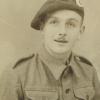In 1947 a Territorial Airborne Division was formed to compensate for the disbandment of the three wartime Airborne Divisions and Independent Brigade Group, to one regular Airborne Brigade.
The new Territorial Army (TA) Division was commanded by Maj Gen R E Urquhart who had commanded the 1st Airborne Division at Arnhem. Its three brigades were recruited throughout the length and breadth of Britain, with the 4th under Brigadier S J Hill centred on London, the 5th under A H Ricketts at York and the 6th under G P Weston at Liverpool. Like its decorated wartime commanders the nine battalions attracted many volunteers who had served with airborne forces during the war. Designated the 16th Airborne Division, the title recalled its respected 1st and 6th Division predecessors.
In 1950 the brigades were renamed the 44th, 45th and 46th Parachute Brigades.
Further reductions in 1956 saw the Division reduced to a single brigade group called the 44th Independent Parachute Group (TA). There were initially five battalions: the 10th (City of London), 12th (Yorkshire), 13th (Lancashire), 15th (Scottish) Parachute Battalions and the 17th (Durham Light Infantry), all TA. The 12th and 13th were shortly amalgamated.
By 1967 the brigade had reduced further to three battalions, with the 4th Battalion emerging from an amalgamation of the 12th/13th and 17th Battalions. In common with the regular army the TA was down to a three battalion group. 44th Parachute Brigade Volunteers (V) consisted now of the 4th (V) Battalion with its HQ at Pudsey near Bradford, the 10th (V) centred on London and the 15th (SV) Battalion based in Glasgow with companies throughout Scotland; including the 16th (Lincoln) Independent Company The Parachute Regiment (V). The Brigade was supported by its own integral Airborne Supporting Arms and Services.
In 1978 44th Parachute Brigade was disbanded as part of TA reductions. The three volunteer parachute battalions survived, except 16th (Lincoln) Independent Company was absorbed into 15 PARA (V), losing its independent status and then later transferring again to 4 PARA (V) in 1983.
The three Volunteer Parachute Battalions became independent units within the UK Home Commands in which they were based. Regimental policy and administration was vested in the Regimental Colonel based at RHQ The Parachute Regiment at Aldershot. All three battalions shared an operational role in BAOR (The British Army of the Rhine) from the early 1980s within the 1st (UK) Armoured Division Order of Battle.
In January 1989 a trial was conducted to test the feasibility of the three battalions operating as a ‘Task Force’ commanded by a light brigade headquarters centred on RHQ PARA, commanded by the Regimental Colonel. The new force had a FIBUA (Fighting in Built-Up Areas) role in BAOR and was called The Parachute Regiment Group (PRG).
After the demise of the Soviet Union ‘Options for Change’ Defence Reviews resulted in the amalgamation of 4 PARA (V) and 15 PARA (SV) in 1993, which was followed by the disbandment of 10 PARA(V) in 1999. Disbanded battalions have been retained as company representative groups within 4 PARA(V), the sole remaining TA parachute battalion.
TA soldiers have been serving with regular Parachute Battalions on a regular basis as piece-meal reinforcements beginning with Northern Ireland and continuing since in the Falkland Islands, Balkans and the Middle East and more recently Afghanistan.
Areas Involved:
Northern Ireland
UN Peace-Keeping Tours
Falkland Islands
Balkans
Iraq 1991 and 2003
Afghanistan





Latest Comments
There are currently no comments for this content.
Add Comment
In order to add comments you must be registered with ParaData.
If you are currently a ParaData member please login.
If you are not currently a ParaData member but wish to get involved please register.